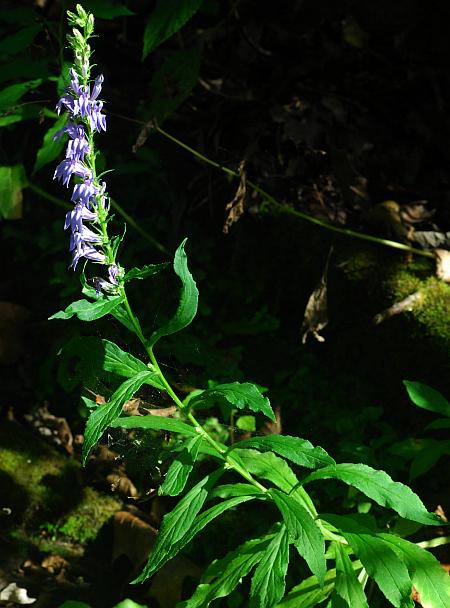Lobelia siphilitica L.
Great Blue Lobelia

Native
CC = 4
CW = -5
MOC = 90
© SRTurner
Lobelia siphilitica L.Great Blue Lobelia | |
 |
Native CC = 4 CW = -5 MOC = 90 |
© SRTurner |
|
Family - Campanulaceae Habit - Perennial forb with fibrous roots. Stems - Ascending to erect, to 1 m, unbranched or less commonly few-branched toward the tip, often slightly winged, with milky sap, glabrous or sparsely pubescent with short, loosely ascending hairs.
Leaves - Alternate, simple, mostly sessile, gradually reduced from about the stem midpoint to the stem tip. Blades 2-15 cm long, 0.5-6.0 cm wide, lanceolate to elliptic, narrowly oblong, or oblanceolate, angled or tapered at the base, the base usually somewhat decurrent below the attachment point as a pair of narrow wings along the stem, rounded or more commonly angled or tapered to a bluntly or sharply pointed tip, the margins finely and bluntly to sharply toothed, the surfaces glabrous or less commonly the undersurface with sparse, short hairs or minutely roughened along the veins.
Inflorescences - Dense terminal racemes. Flower stalks mostly 3-9 mm long, subtended by leafy bracts, these gradually reduced upward, each flower also with a pair of minute bracts immediately below or farther below the calyx.
Flowers - Resupinate. Calyces 8-18 mm long, the tube 2-4 mm long at flowering, becoming somewhat enlarged as the fruit matures, the slender lobes 6-14 mm long, becoming somewhat elongated as the fruit matures, with relatively long, conspicuous auricles. Corollas zygomorphic, bilabiate, 16-32 mm long, 5-lobed, blue to bluish purple, sometimes with white, longitudinal striping, the outer surface glabrous or with short, spreading hairs along the veins, the tube 11-20 mm long, with slitlike openings (fenestrate), the lobes 5-12 mm long. Filaments fused into a tube 12-15 mm long, blue, encasing the style. Anther tube 3-5 mm long.
Fruits - Hemispherical capsules 5-9 mm long, ornamented by persistent calyx, corolla, and organs. Seeds 0.6-0.8 mm long, ellipsoid, the surface with a series of minute pits and ridges, yellowish brown.
Flowering - August - October. Habitat - Streambanks, pond margins, bottomland forests, prairie swales, sloughs, swamps, fens, other moist areas including bluff ledges, pastures, ditches, and roadsides. Origin - Native to the U.S. Lookalikes - L. puberula, which is rare in Missouri. Other info. - This easily recognized species is common throughout Missouri, as well as the upper U.S. Midwest and New England. When flowering it is easily recognized by the blue-purple, bilabiate flowers borne in a spikelike raceme. White flowered forms are occasionally encountered. The species is quite common along pond margins and and in wet woods and meadows. The brilliant flowers have earned the plant a place in cultivation, and it is a good choice for continually moist, shaded garden spots. Like other members of the genus, the plant contains piperidine and tetrahydropyridine alkaloids which render it toxic. Photographs taken in the Ozark Scenic Riverways, Shannon County, MO., 8-15-03(DETenaglia); also at Little Lost Creek Conservation Area, Warren County, MO, 9-6-2015 and 10-9-2020 (SRTurner). |